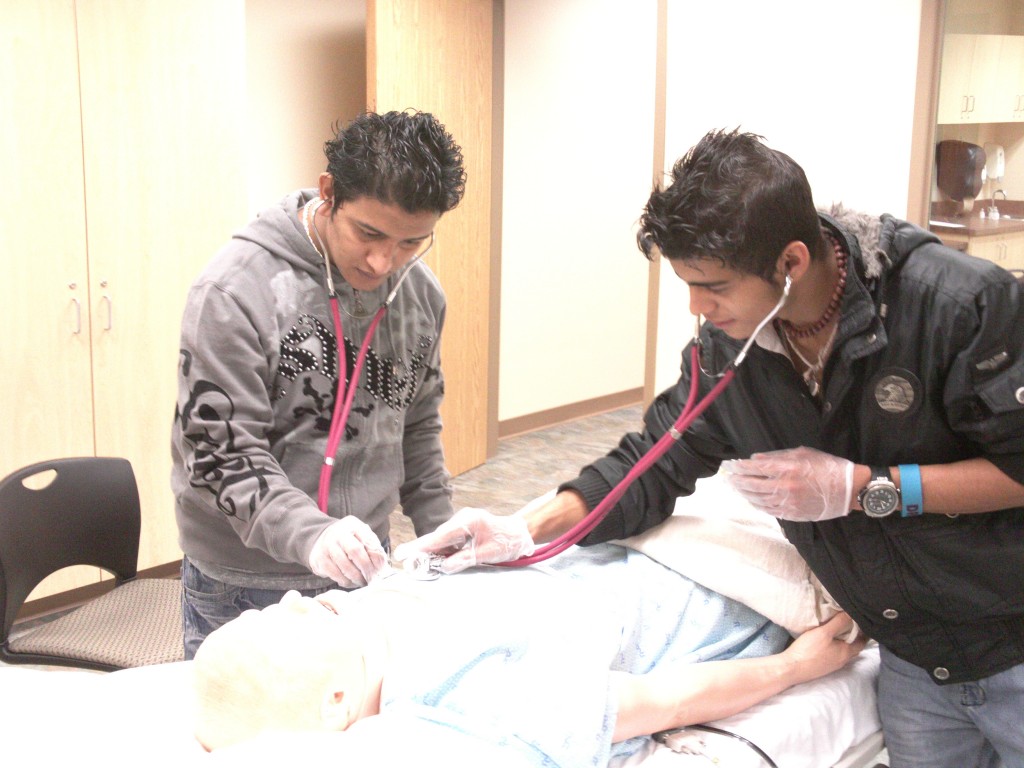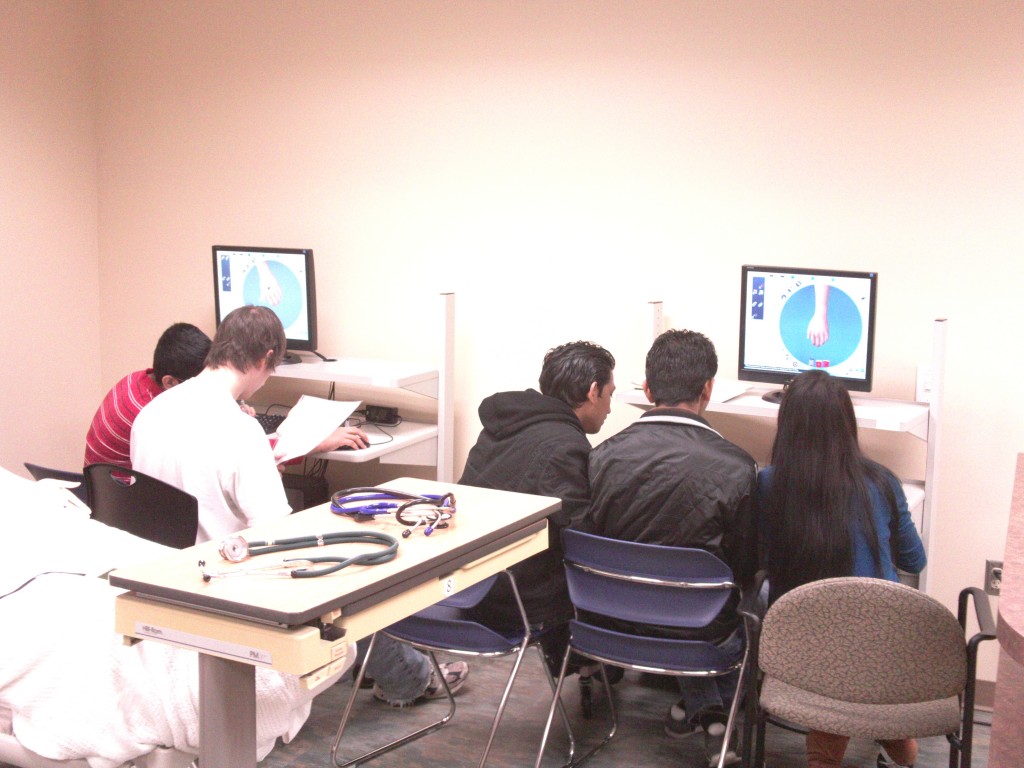Akram Bhatti, Simulation Technologist and Educator wrote in to HealthySimulation.com to share the partnership opportunities his Simulation Center at Gannon University coordinated with local high schools. Christian Chapa, Science Teacher Charter School of Excellence also contributed to this article.
(Do you have similar article to share with over 3,600 other simulation champions? Share your work by emailing Lance today!)
Patient Simulation, Science and High Schoolers….
A bright group of students from Charter School of Excellence (CSE) came through the Patient Simulation Center at Gannon University asking insightful and penetrating questions about the field of patient simulation technology and its integration into the health professions. I was intrigued. Usually students exclaim wonder at the expense of the equipment and the surreal similarities between the hi-fidelity manikins and human beings but do not connect the technical work involved with science educational principles. This was a different group altogether, asking about software used to control the manikins, how the audio visual systems work to create debriefing files, and the compelling “why” of the function of the center. I approached their science teacher, Cristian Chapa, about collaboratively creating biology modules with an integration of simulation technology that would intersect his science curriculum with the technology at the center. In the following pages what will follow is an informal report of our work together: myself as simulation technologist creating the bridge to deliver the biology curriculum of his anatomy and physiology class. We will begin with an introduction to the school represented plus a brief introduction to the Patient Simulators and Simulation Technology with finally some conclusions on how science education can be transformed through partnerships with a local simulation center and in turn its technical tools being able to further stimulate high school students in order to pursue majors in the science, technology, engineering and math fields (STEM). Click on the “read more” link below to begin with an introduction to the innovative CSE…
Perseus Charter School of Excellence
The Charter School of Excellence is located in downtown Erie, PA and is open to all high school aged students in Erie County. The school opened in 2005 originally as an alternative for students that struggle in a traditional high school setting, though the school has expanded to include a college preparation program, culinary arts, and studio production. The diversity of the Charter School of Excellence is characteristic of schools in an urban setting. Seventy percent of the students receive free or reduced lunches and 25% are English Language Learners. The students participated in the simulation in order to apply anatomy and physiology from the classroom to experience nursing protocol and procedure, relate clinical values to symptoms, ailments and diseases, develop problem solving and team building skills. Specifically, students evaluated the cardiovascular and respiratory system on patient simulators-high and low fidelity- measuring pulses, heart rhythms, blood pressure, and breathing. In addition to the cardiovascular and respiratory system venipuncture, collection of blood from a vein, training was also addressed in a separate simulation module.
Students passed a pre-laboratory quiz to ensure that students arrived to the simulation center with a general understanding of the lab. At the simulation center students were debriefed on descriptions of possible scenarios, and specific guidelines for the lab. A demonstration on the internal wiring of a simulation manikin followed.
Students worked in pairs and were assigned a manikin when evaluating the circulatory and respiratory system. The students learned how to select the various values and conditions; 155/110, murmur, wheezes, crackles, etc., on the manikin as well as use the stethoscope and sphygmomanometer. After familiarity and practice one student from each pair would select conditions or values and the other student would have to correctly diagnosis the condition or blood pressure values. Blood pressure values had to be within five for a correct answer. For example, if 155/110 was selected an answer of 145/115 would receive full credit. After the students practiced among themselves the teacher would come by and quiz the students by selecting conditions and values. The students would diagnose and record the values of each simulation.
After the simulations were completed the biology of the patients was discussed with particular focus on the heart and lungs. The focus, specifically, was the physiology and adaptations during each simulation. Students used this information to write a laboratory report discussing these changes and adaptations of their simulations in addition to the procedure and usage of the medical instruments and other protocols.
Student participation and engagement was high. Students that are normally shy were taking the lead and answering and asking questions. In a survey after the simulations students stated they gained a better understanding of the content. They also had fun. Post quizzes and laboratory reports were indicative of student growth and understanding. All of the above was conducted at the center located in Erie, Pennsylvania.
Patient Simulation Center
The Patient Simulation Center at Gannon University has been in operation for three years since 2009. It is located in the Morosky Building which houses the health professional programs: Occupational and Physical Therapy, Physician Assistant, Nursing, Radiological Sciences and Exercise and Sports Science. The Simulation Center is designed to house multi-disciplinary scenarios, improve patient care and reduce medical errors. Gannon University has created a fully computerized center with the latest in teaching technologies and audio visual equipment in order to record and playback scenarios.
In the fall of 2011 in a discussion with Cristian Chapa, science teacher at CSE, led to a plan to create scenarios integrating simulation technology into his science curriculum. At the time many of the scenarios were designed with a strong clinical focus and for college-level students. However, through an intensive collaboration both on a conversation and writing level we were able to create four modules. In this paper we will highlight two modules which focused on teaching students about blood pressure and heart rhythms. The patient simulators are designed for students to experience hands-on learning. For example, how does it feel to have low and high blood pressure or rapid heart rate such as atrial fibrillation. We concluded that simulation technology and patient simulators has massive potential to transform science education and training. The leadership and faculty at CSE are taking the “road” less followed perspective and becoming a pioneer in science simulation education. In short this article will discuss what is patient simulation and simulators; discuss the links between science education and simulation; present the science module created and its link with the patient simulators and finally concluding thoughts on how to create science-based simulation modules and the value of creating partnerships with your local simulation center and the corporate entities that represent them. Patient simulators are made by many companies among the more prominent are Gaumard and Laerdal.
Patient Simulators and Simulation
Manikins act in place of live a clinical patient. No harm can be done in other words it is not a life or death situation. Therefore, there is room allowed for as many errors by high school students and they can practice without pressure to improve technique and protocols. Science practitioners and high school students alike can use patient simulators to improve their patient and team communication skills in simulated scenarios either in a multi-skills training room environment or a simulated health care setting. The simulation center replicates a multidisciplinary setting to give health care professionals and trainees a real-world environment in which to learn, practice and master the latest techniques for patient care and treatment. High-fidelity life-sized robotic “patients” (Sim Man, SimBaby, Sim NewB) mimic patient sounds, ailments and other communication variables. The manikins breathe, speak and have a variable pulse and heart rate and rhythm.
Simulations allow high school students to practice without being in a high stakes real life health care setting and learn without pressure of an impending examination or test. Through simulation trials students will learn in an accelerated manner and through continuous simulation will fully accustomed to the stress and demands of the health care professional curriculum if they choose to pursue a health care major. Medical simulation training is modeled after military and commercial airline safety simulation. This type of training enhances education and allows for repetitive skills practice with zero chance of injury to the student. High school students will benefit greatly by having simulation education and technology integrated into their science curriculum.
The Patient Simulation Center, Science Education and Perseus Charter
As a pioneer in the growing field of simulation education in science education and multidisciplinary training the patient simulation center became an open testing laboratory for simulation trials that were run in 2011-2012 academic year. We trained students through mid-fidelity patient simulators (Nursing Annies) in lung sound diagnosis and treatment; blood pressure calibration plus with the use of high fidelity manikins CSE students were able to practice listening for various heart rhythms and administering proper protocol. Students were also able to view their practice sessions through the use of interactive video recording equipment. There are three cameras in each room with one pan tilt zoom camera. Either through live-streaming or playing a video file after the scenario students could evaluate his or her own performance. Patient Simulators and simulation technologies and video recording equipment plus Sim Man software reduce adverse medical events and improves learning and fosters team building skills.
To learn more, email Akram today!








